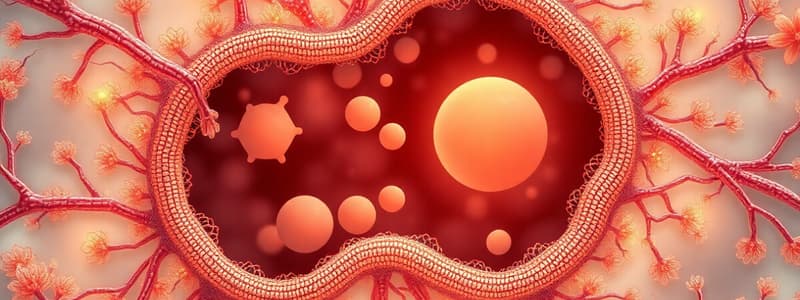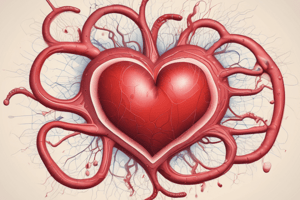Podcast
Questions and Answers
What is the primary neurotransmitter released by sympathetic post-ganglionic neurons?
What is the primary neurotransmitter released by sympathetic post-ganglionic neurons?
- Dopamine
- Serotonin
- Acetylcholine
- Norepinephrine (correct)
Which effect does the binding of norepinephrine to alpha adrenergic receptors primarily cause?
Which effect does the binding of norepinephrine to alpha adrenergic receptors primarily cause?
- Decreased heart rate
- Increased nitric oxide production
- Vasodilation of all blood vessels
- Vasoconstriction of arterioles and venules (correct)
How is angiotensin II formed from its precursor molecules?
How is angiotensin II formed from its precursor molecules?
- Renin converts angiotensinogen into angiotensin I, which is then activated into angiotensin II. (correct)
- Angiotensinogen is converted directly into angiotensin II by the kidneys.
- Angiotensin I is converted into angiotensin II through direct vascular stimulation.
- Renin acts directly on angiotensin II to enhance its effects.
Which of the following tissues primarily experience vasodilation via sympathetic active vasodilator nerves?
Which of the following tissues primarily experience vasodilation via sympathetic active vasodilator nerves?
What initiates the release of renin from juxtaglomerular cells in the kidneys?
What initiates the release of renin from juxtaglomerular cells in the kidneys?
What is the primary function of endothelin (ET-1) once released into the bloodstream?
What is the primary function of endothelin (ET-1) once released into the bloodstream?
Which of the following factors stimulates the formation and release of ET-1?
Which of the following factors stimulates the formation and release of ET-1?
The process of reactive hyperemia is primarily characterized by what physiological change?
The process of reactive hyperemia is primarily characterized by what physiological change?
Which of the following molecules inhibits the release of ET-1?
Which of the following molecules inhibits the release of ET-1?
How does endothelial-derived ET-1 primarily influence vascular smooth muscle?
How does endothelial-derived ET-1 primarily influence vascular smooth muscle?
What determines the extent and duration of reactive hyperemia?
What determines the extent and duration of reactive hyperemia?
Which of the following vasoactive metabolites is continuously produced during normal metabolism?
Which of the following vasoactive metabolites is continuously produced during normal metabolism?
Endothelin is derived from a precursor of how many amino acids?
Endothelin is derived from a precursor of how many amino acids?
Which of the following is considered one of the most potent vasoconstrictors known?
Which of the following is considered one of the most potent vasoconstrictors known?
What role does nitric oxide play in relation to ET-1?
What role does nitric oxide play in relation to ET-1?
What triggers the vasodilation of arterioles during reactive hyperemia?
What triggers the vasodilation of arterioles during reactive hyperemia?
Which of the following plays a significant role in mediating active hyperemia?
Which of the following plays a significant role in mediating active hyperemia?
What is the effect of nitric oxide (NO) blockade during reactive hyperemia?
What is the effect of nitric oxide (NO) blockade during reactive hyperemia?
The increase in blood flow during reactive hyperemia primarily serves what purpose?
The increase in blood flow during reactive hyperemia primarily serves what purpose?
Active hyperemia is best described by which statement?
Active hyperemia is best described by which statement?
Which of the following metabolites is NOT typically associated with vasodilation during active hyperemia?
Which of the following metabolites is NOT typically associated with vasodilation during active hyperemia?
How does flow-mediated vasodilation occur in relation to shear stress?
How does flow-mediated vasodilation occur in relation to shear stress?
What is the primary physiological significance of autoregulation?
What is the primary physiological significance of autoregulation?
During vasodilation in skeletal muscle, what role does your body’s metabolism play?
During vasodilation in skeletal muscle, what role does your body’s metabolism play?
What is the primary function of autoregulation in blood flow?
What is the primary function of autoregulation in blood flow?
Which hypothesis explains the initial increase in blood flow due to increased perfusion pressure as well as the subsequent decrease?
Which hypothesis explains the initial increase in blood flow due to increased perfusion pressure as well as the subsequent decrease?
Which vascular beds are noted to display effective autoregulation?
Which vascular beds are noted to display effective autoregulation?
What occurs in the myogenic hypothesis in response to an increase in perfusion pressure?
What occurs in the myogenic hypothesis in response to an increase in perfusion pressure?
How does decreased perfusion pressure affect blood flow according to the metabolic hypothesis?
How does decreased perfusion pressure affect blood flow according to the metabolic hypothesis?
Which of the following statements about autoregulation is NOT true?
Which of the following statements about autoregulation is NOT true?
What is the consequence of increased blood flow through metabolic vasodilators, according to the metabolic hypothesis?
What is the consequence of increased blood flow through metabolic vasodilators, according to the metabolic hypothesis?
Which statement best describes the relationship between perfusion pressure (P), flow (F), and resistance (R)?
Which statement best describes the relationship between perfusion pressure (P), flow (F), and resistance (R)?
What is primarily responsible for the decrease in blood flow back toward normal levels in the myogenic hypothesis?
What is primarily responsible for the decrease in blood flow back toward normal levels in the myogenic hypothesis?
What primary factors regulate local blood flow?
What primary factors regulate local blood flow?
Which hypothesis explains autoregulation related to blood pressure changes in tissues?
Which hypothesis explains autoregulation related to blood pressure changes in tissues?
Which substance, produced by the endothelium, plays a crucial role in vasodilation?
Which substance, produced by the endothelium, plays a crucial role in vasodilation?
What role does soluble guanylate cyclase play in the vasodilation process initiated by nitric oxide?
What role does soluble guanylate cyclase play in the vasodilation process initiated by nitric oxide?
Which receptors are involved in remote control of circulation through hormonal signals?
Which receptors are involved in remote control of circulation through hormonal signals?
How does tissue pressure influence local blood flow regulation?
How does tissue pressure influence local blood flow regulation?
What is the primary function of the endothelium in blood vessel regulation?
What is the primary function of the endothelium in blood vessel regulation?
Which term describes the increase in blood flow that occurs after a period of occlusion?
Which term describes the increase in blood flow that occurs after a period of occlusion?
What stimulates the additional release of endothelin (ET-1) from the vascular endothelium?
What stimulates the additional release of endothelin (ET-1) from the vascular endothelium?
Which physiological process is primarily characterized by elevated blood flow after the release of an obstruction?
Which physiological process is primarily characterized by elevated blood flow after the release of an obstruction?
What is the primary effect of endothelin (ET-1) binding to its receptors in vascular smooth muscle?
What is the primary effect of endothelin (ET-1) binding to its receptors in vascular smooth muscle?
How is the extent of reactive hyperemia influenced?
How is the extent of reactive hyperemia influenced?
Which of the following substances inhibits the release of endothelin (ET-1)?
Which of the following substances inhibits the release of endothelin (ET-1)?
Which of the following best describes the difference between active hyperemia and reactive hyperemia?
Which of the following best describes the difference between active hyperemia and reactive hyperemia?
What role does Nitric Oxide play in the regulation of vascular smooth muscle activity?
What role does Nitric Oxide play in the regulation of vascular smooth muscle activity?
Which hypothesis explains the initial increase in blood flow due to an increase in perfusion pressure?
Which hypothesis explains the initial increase in blood flow due to an increase in perfusion pressure?
Which type of receptor is NOT typically associated with the remote control of circulation?
Which type of receptor is NOT typically associated with the remote control of circulation?
What is the primary physiological mechanism of autoregulation in response to increased perfusion pressure?
What is the primary physiological mechanism of autoregulation in response to increased perfusion pressure?
What mechanism is primarily involved in the decrease of blood flow following an increase in perfusion pressure according to the metabolic hypothesis?
What mechanism is primarily involved in the decrease of blood flow following an increase in perfusion pressure according to the metabolic hypothesis?
Which statement accurately reflects the relationship between perfusion pressure, blood flow, and vascular resistance?
Which statement accurately reflects the relationship between perfusion pressure, blood flow, and vascular resistance?
In the myogenic hypothesis, what is the primary response of vascular smooth muscle when subjected to increased tension?
In the myogenic hypothesis, what is the primary response of vascular smooth muscle when subjected to increased tension?
Which of the following best describes the autoregulatory range?
Which of the following best describes the autoregulatory range?
What occurs in vascular beds that do not exhibit marked autoregulation when perfusion pressure changes?
What occurs in vascular beds that do not exhibit marked autoregulation when perfusion pressure changes?
According to the myogenic hypothesis, what happens to blood flow when perfusion pressure decreases?
According to the myogenic hypothesis, what happens to blood flow when perfusion pressure decreases?
What defines the metabolic hypothesis in the context of blood flow regulation?
What defines the metabolic hypothesis in the context of blood flow regulation?
In what way does autoregulation differ between the kidneys and skeletal muscle?
In what way does autoregulation differ between the kidneys and skeletal muscle?
How does sustained increased perfusion pressure affect blood flow over time?
How does sustained increased perfusion pressure affect blood flow over time?
Study Notes
Local Control Mechanisms
-
Endothelium
- Plays an active role in regulating vascular smooth muscle activity by releasing vasoconstrictors and vasodilators.
- Nitric Oxide (NO):
- Endothelial cells constantly produce nitric oxide.
- NO is a vasodilator.
- NO is synthesized by nitric oxide synthase (NOS) from L-arginine.
- NO diffuses into vascular smooth muscle and stimulates soluble guanylate cyclase, increasing cGMP levels.
- Endothelin (ET-1):
- A potent vasoconstrictor.
- A 21 amino acid peptide produced by the vascular endothelium.
- Released by stimulation by angiotensin II (AII), antidiuretic hormone (ADH), thrombin, cytokines, reactive oxygen species, and shearing forces.
- Inhibition by prostacyclin, atrial natriuretic peptide, and nitric oxide.
- Binds to receptors on vascular smooth muscle, increasing calcium release from the sarcoplasmic reticulum and promoting contraction.
-
Reactive Hyperemia:
- Increase in blood flow to an organ after a period of occlusion.
- Caused by:
- Tissue hypoxia
- Build-up of vasoactive metabolites
- The extent and duration of reactive hyperemia depend on the duration of the occlusion.
- Role of Nitric Oxide:
- Increased shear stress on the endothelium during the increased blood flow stimulates NO production and release.
- NO blockade reduces the peak and duration of reactive hyperemia.
-
Active Hyperemia:
- Increase in blood flow to an organ due to increased metabolic activity.
- The extent of the increase in blood flow is proportional to the magnitude of the increase in metabolic rate.
- Similar mechanisms to reactive hyperemia:
- Increased production of vasodilators (H+, lactate, K+, CO2, adenosine, prostaglandins)
- Flow mediated vasodilation via NO release
-
Autoregulation:
- The ability of an organ or tissue to maintain a relatively constant blood flow despite changes in perfusion pressure.
- Two major hypotheses explain autoregulation:
- Metabolic Hypothesis: Increased pressure leads to initial increased blood flow, which washes out vasodilators and causes vasoconstriction.
- Myogenic Hypothesis: Increased pressure causes tension on vascular smooth muscle, leading to contraction and vasoconstriction.
- Autoregulation is most effective within a specific range of arterial pressures (autoregulatory range).
Remote Control Mechanisms
-
Neural Control:
- Control by the autonomic nervous system, primarily the sympathetic nervous system.
- Sympathetic post-ganglionic neurons use norepinephrine (NE) as the primary neurotransmitter.
- NE binds to alpha adrenergic receptors, causing vasoconstriction in arterioles and venules.
- Sympathetic active vasodilator nerves cause vasodilation in skeletal muscle and skin; the neurotransmitter is unknown.
- Parasympathetic nervous system innervates blood vessels in the genitals, heart, and brain.
- Parasympathetic activation releases acetylcholine (Ach), which binds to muscarinic receptors on the endothelium, leading to NO release.
-
Circulating Factors:
- Renin-Angiotensin II System:
- Renin is released from the juxtaglomerular cells of the kidneys in response to decreased arterial pressure, increased renal sympathetic nerve activity, or decreased sodium load.
- Renin converts angiotensinogen to angiotensin I.
- Angiotensin I is converted to angiotensin II by angiotensin converting enzyme (ACE).
- Angiotensin II activates vascular AII receptors, causing vasoconstriction.
- The renin-angiotensin II system is a key player in blood pressure regulation.
- Renin-Angiotensin II System:
Local – Remote Interaction
- Local control and remote control mechanisms interact to regulate blood flow.
Studying That Suits You
Use AI to generate personalized quizzes and flashcards to suit your learning preferences.
Related Documents
Description
Explore the vital roles of the endothelium in vascular regulation. This quiz covers the mechanisms of nitric oxide as a vasodilator and endothelin as a vasoconstrictor, including their biochemical pathways and physiological effects. Test your understanding of how these substances impact vascular smooth muscle activity.



